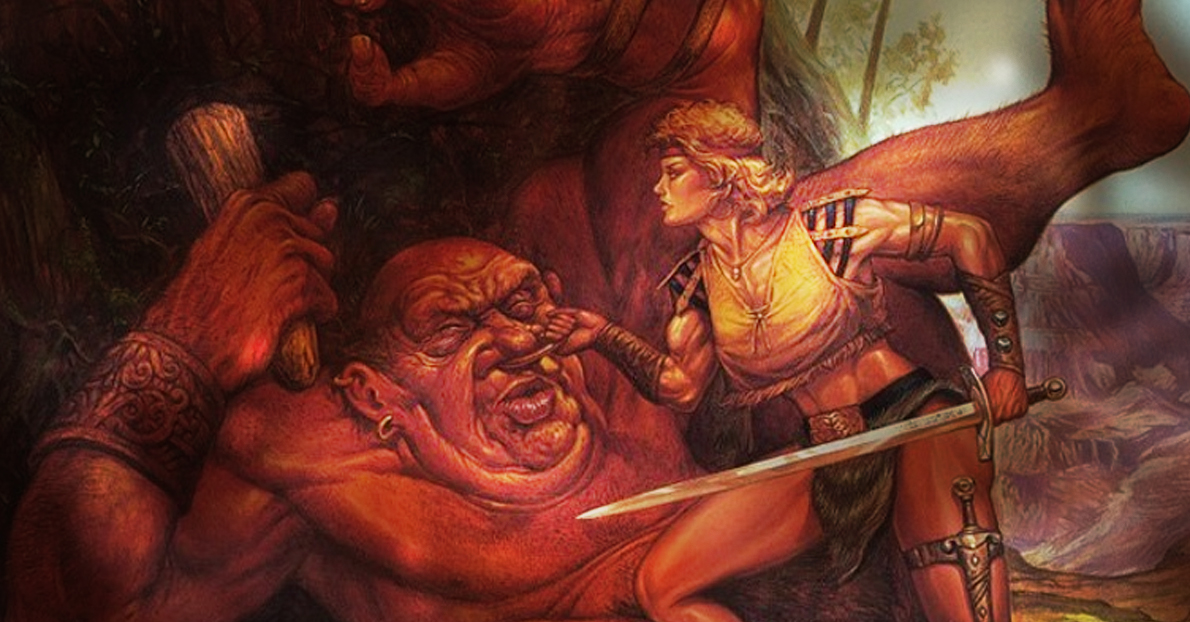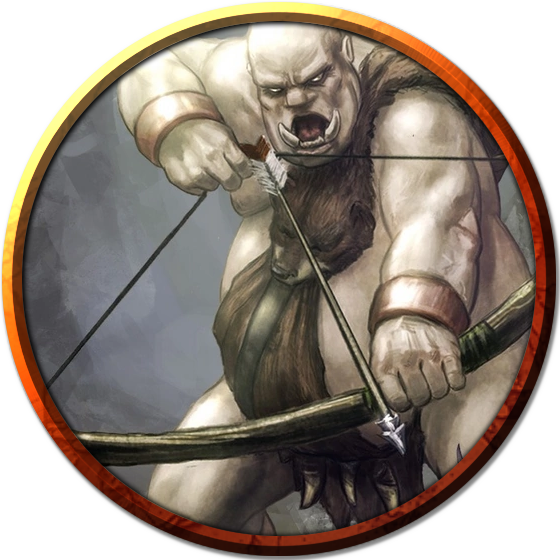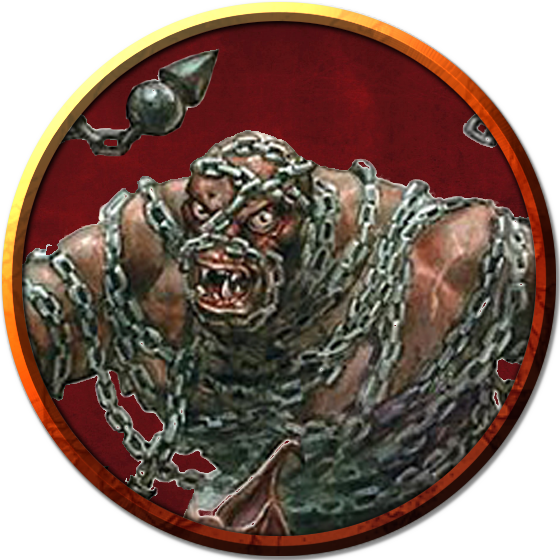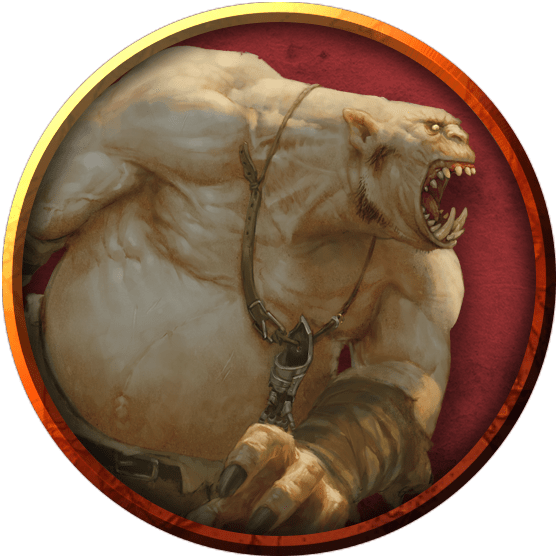Ogre (/ˈoʊɡə/)
The hulking humanoids
“Worst. Dancers. Ever.”
The Menagerie fought some that straggled into the Tharros Underdark Hideout "Near" Outding Refuge. Later they fought some Chain Brutes and Bolt Launchers on the Road North of Skola Vale
Basic Information
Anatomy
Description
Ogres appeared as giant humanoids with very muscular bodies and large heads. They stood between 9 and 10 feet tall and could weigh 600 to 650 lbs.Subraces
Half-ogre
Half-ogres were a crossbreed of ogre that was somewhat smarter and weaker than the standard ogre race. They could sometimes pass as unusually large, albeit ugly, humans.Merrow
Merrows were ogres adapted to the water.Ice Spire ogre
An ogre subrace found in the Ice Spires region.Ogrillon
The result of ogre-orc crossbreeding.Zakharan ogre
Civilized ogres that were common in the southern continent of Zakhara.Behaviour
Personality
Ogres were a lazy, brutish, avaricious race with notoriously quick tempers. Their avaricious nature would often lead them distrust one another and incite squabbling over treasure.Combat
Ogres generally preferred to rely on ambushing their foes and overwhelming them through sheer numbers. In terms of weapons, ogres were typically seen to use uprooted trees and stone-tipped javelins.Additional Information
Social Structure
Society
Much like hill giants, ogres were gluttonous creatures willing to eat almost anything. They enjoyed the taste of raw dwarf flesh, but would also eat halfling or elf flesh when they could get it. They would often use the skin and bones of their prey to fashion crude loincloths and necklaces. Ogres were known to typically associate with goblinoids, orcs, and their fellow giant-kin trolls. In the social structure of the giants, the Ordning, ogres were considered the lowest-ranked of all giant-kin. Because of this, they were typically found to be willing servants of giants. The giant races they were most often seen working alongside were hill giants and verbeeg, the former of which they often traded with for trinkets or food. Many ogres worked as mercenaries, hoping for easy plunder, and in that line of work they were often seen alongside verbeeg. Lone hags, as well as covens, were known to employ ogres as guards, while others polymorphed ogres and sent them out to work as spies.Ogre Bolt Launcher
MPMM (p200) A bolt launcher carries a gigantic crossbow—a weapon so large it's essentially an ogre-held ballista. An ogre bolt launcher can load this immense weapon and loose its deadly missile as quickly as a dwarf handles a crossbow. The bolts are so large that few ogres can carry more than a half dozen at a time, but bolt launchers have been known to uproot small trees or tear beams out of buildings and launch those when their ammunition runs low.Ogres of War
Ogres love to rush headlong into battle, but with enough time and patience, some of them learn to carry out specialized missions. The names they are given—the battering ram, the bolt launcher, the chain brute, and the howdah—reflect their particular functions. These jobs are tailored to take advantage of an ogre's strengths.Uses, Products & Exploitation
Harvesting
Instructions| DC | Item | Description | Value | Weight | Expiration | Crafting |
|---|---|---|---|---|---|---|
| 10 | Ogre Fat (large pouch) | An Ogre has a thick layer of fat under its filthy skin. It can be difficult to cut away enough useful fat, depending on the harvester's skill. The fat can be used to make soaps and candles. | 3 gp | 4 lb. | 2 days | Repelling Candle (HHH) |
| 15 | Ogre Skin | An ogre has a large, rough layer of pale skin. While strong and durable, leather made from the skin is not very aesthetic and has an odd smell (even after being treated). | 4 gp | 10 lb. | 10 days | - |
| 20 | Ogre Stomach | Ogres are known to be voracious eaters, and have an enlarged, elastic stomach with a strong lining. Leatherworkers can treat and fashion larger than normal sack and bags. While these bags are larger (50% bigger), they do not increase a character's encumbrance. | 10 gp | 4 lb. | 2 days | - |
| 15 | Ogre Blood (5 vials) | Brutish, rough, and very large, the hands of an ogre are meant for little more than wielding a club to smash those smaller than their owner. | 5 gp | 4 lb. | 2 days | Gauntlets of Ogre Power |
| 5 | Chain Brute ONLY: Ogre's Giant Chain | A chain ogre carried an enormous iron chain. The chain is over 15 feet long and weighs over 150 lbs. Each link is 6 inches thick, 1 foot long, and 8 inches wide. The chain is poorly forged, but shipbuilders, architects and smiths may find it useful. If the harvesting check is failed, the quality is extremely poor or the chain was shattered to pieces during the fight. | 80 gp | 150 lb. | ∞ | - |
This kind of creature may carry a few coins. This kind of creature may have a small hoard. This character usually carries: 1 Greatclub, 1d4 Javelin, 1 Hide (Large creatures tend to use larger standard weapons, like greatswords and greatclubs, but it is the DM's discretion if the items are usable or have a modified weight/value.)
Possible Trinkets
Possible trinkets
1d20 Item Weight Value 1 1 leather strap with 3 humanoid skulls 20 lb. 5 sp 2 1 waterskin full of cheap wine 5 lb. 4 sp 3 1 necklace of various teeth 1 lb. 3 sp 4 1 crude wooden statue of Vaprak the Destroyer 3 lb. 5 sp 5 1 gnawed thigh bone 3 lb. -- 6 1 gnarled tree branch, oddly tied into a knot 5 lb. 1 cp 7 1 silver longsword, bent (90 degrees) 3 lb. 20 gp 8 1 pouch of human teeth, each painted a different color 1 lb. 4 sp 9 1 bloody medallion with an unrecognizable symbol (possible plot hook) 1 lb. 1 gp 10 1 hard clump of dirt [DC 15 Investigation Check, on success finds a gem worth 25gp inside, failure finds nothing] -- -- 11 1 large drum made with a wooden barrel and stretched human skin 40 lb. 3 gp 12 1 desiccated bear paw tied to a string 3 lb. 2 cp 13 1 overstuffed cloth child's doll, with hay bursting at the seams 3 lb. 3 sp 14 1 helm, crumpled like a tin can 5 lb. 5 cp 15 1 clay jar of bloody, mashed up remains 6 lb. -- 16 1 large toothpick-shaped bone (crude rapier, only 1d6 damage) 3 lb. 5 sp 17 1 large ball of clay, with a bite eaten out of it 50 lb. 5 sp 18 1d4 slab(s) of raw meat (spoils in 1 day) 4 lb. 2 sp 19 1d4 small animal carcass(es) 1 lb. 1 sp 20 1d6 piece(s) of colored chalk -- 3 cp
This creature produces 6-36 pieces of Harvested Meat, weight total of 24-144 lb. DC: 5, Expire: 1 day, Value: 12-72 sp There is a stigma to eating meat belonging to sentient creatures that have a humanoid form and features. Harvesting the meat may be frowned upon and even considered cannibalism. Some communities may refuse to buy the meat (and some evil communities may pay a premium). The meat may even be difficult to eat, or unedible. Of course, these are all up to the Dungeon Master to decide.
Civilization and Culture
Major Language Groups and Dialects
Language
Ogres spoke Jogishk, a patois of the Giant or Jotun tongue.Common Customs, Traditions and Rituals
Religion
Ogres typically worshiped Vaprak the Destroyer as their patron god. Though many also practically worshiped the true giants.History
Historical Figures
Sources
Source(s):
- Mike Mearls, Jeremy Crawford, Christopher Perkins (2014-09-30). Monster Manual 5th edition. Edited by Scott Fitzgerald Gray. (Wizards of the Coast), pp. 237–238. ISBN 978-0786965614.
- Mike Mearls, Stephen Schubert, James Wyatt (June 2008). Monster Manual 4th edition. (Wizards of the Coast), pp. 198–199. ISBN 978-0-7869-4852-9.
- Skip Williams, Jonathan Tweet, Monte Cook (July 2003). Monster Manual v.3.5. (Wizards of the Coast), pp. 198–200. ISBN 0-7869-2893-X.
- Doug Stewart (June 1993). Monstrous Manual. (TSR, Inc), pp. 272–273. ISBN 1-5607-6619-0.
- Gary Gygax (December 1977). Monster Manual, 1st edition. (TSR, Inc), p. 75. ISBN 0-935696-00-8.
- Ray Winninger (September 1995). Giantcraft. Edited by Karen S. Boomgarden. (TSR, Inc.), p. 57. ISBN 0-7869-0163-2.
- Dave Gross ed. (1999). Dragon Annual #4 (Wizards of the Coast), p. 29.
- Ray Winninger (September 1995). Giantcraft. Edited by Karen S. Boomgarden. (TSR, Inc.), p. 19. ISBN 0-7869-0163-2.
- Michael Fleisher (March 1989). “Sorcerer's Moon”. Advanced Dungeons & Dragons #4 (DC Comics).
- Doug Stewart (June 1993). Monstrous Manual. (TSR, Inc), pp. 141, 147. ISBN 1-5607-6619-0.
- Ray Winninger (September 1995). Giantcraft. Edited by Karen S. Boomgarden. (TSR, Inc.), p. 34. ISBN 0-7869-0163-2.
- Doug Stewart (June 1993). Monstrous Manual. (TSR, Inc), p. 181. ISBN 1-5607-6619-0.
- Monstrous Compendium included in Tim Beach, Tom Prusa and Steve Kurtz (1993). City of Delights. (TSR, Inc). ISBN 1-56076-589-5.
- Ray Winninger (September 1995). Giantcraft. Edited by Karen S. Boomgarden. (TSR, Inc.), p. 9. ISBN 0-7869-0163-2.
- Richard Baker III, David Cook, Kevin Melka, Bruce Nesmith (January 1997). Introduction to Advanced Dungeons & Dragons. (TSR, Inc.), p. 10. ISBN 0-7869-0332-5.
- Ossian Studios (June 2018). Neverwinter Nights: Darkness over Daggerford. Beamdog.
- Arctic Terrain
- Coast Terrain
- Cold Climate
- Desert Terrain
- Forest Terrain
- Grassland Terrain
- Hill Terrain
- Kampos
- Mountain Terrain
- Polar Climate
- Skola Vale
- Subpolar Climate
- Swamp Terrain
- Temperate Climate
- Tharros Underdark Hideout "Near" Outding Refuge
- The Dark Rain Forest
- Underdark Terrain
- Underground Terrain
5E Statistics
 Ogre
Ogre
| Size | Large |
| Type | Giant |
| Alignment | Chaotic Evil |
| Challenge Rating | 2 |
General Information
| Patron deity | Vaprak |
| Vision | Darkvision, low-light vision |
| Language(s) | Common, Jogishk, Giant |
| Subraces | Merrow |
| Favored Climate | Temperate |
| Favored Terrain | Hill |
Appearance
| Average Height | Male: 10'1" - 10'10" Female: 9'3" - 10'0" |
| Average Weight | 600-690 lbs. Female: 555-645 lbs. |
See Also: Ogre on Forgotten Realms Wiki





